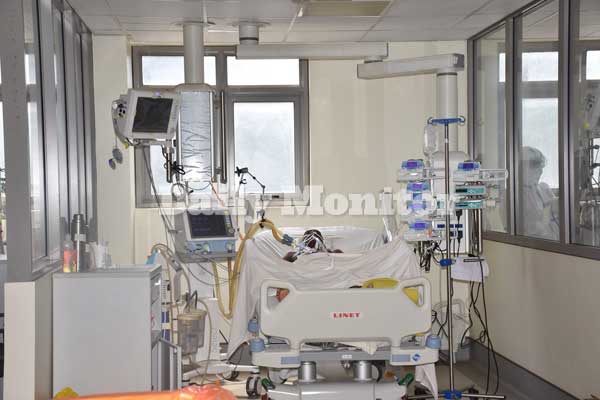Prime
Oxygen scarcity, the nightmare in hospitals

Covid-19 patients at Mulago National Referral Hospital . PHOTO | PROMISE TWINAMUKYE
What you need to know:
- An oxygen saturation of 95 to 100 per cent is considered healthy. However, many people who contract Covid-19 have low oxygen levels which is a threat to their lives. In such cases, oxygen is required fast butwith the scarcity of oxygen, some patients never make it, writes Beatrice Nakibuuka
On June 7, Rhoda called her husband Godfrey Mwanje. She wasn’t feeling well, she said, explaining the symptoms.
Mwanje suspected it was Covid-19 so they took a test the next day. They had just recently picked their daughter from school and many of her colleagues had been admitted with the same condition as Rhoda.
“We got our first Covid-19 vaccine jab on April 27,” says Mr Mwanje. “I was sure that we were safe (from Covid-19) but after the test, my wife was positive and our daughter was negative. When I asked the doctor if I should also test, he said that the results will obviously be positive since I had just been vaccinated, ” says Mwanje.
The doctor advised that I look out for any symptoms and get treated as soon as possible. As the doctor prepared to prescribe medication for them, Mwanje stopped him and told him that they would take medical advice given by the Ministry of Health which includes azithromycin, dexamethasone, vitamin C and D.
The doctor approved.
Mr Mwanje was elated he had fore knowledge about what was to be done and since his wife had been diagnosed early enough, he would definitely be able to take care of her.
After completing the dose, there was no improvement with her breathing becoming laboured by the day.
They drove from Gayaza towards Kampala in search of hospital beds which seemed hard to come by. In Kasangati, she got worse so they rushed her to Agape clinic where she was given an oxygen concentrator that supported her for a night until she got to 96 per cent.
“But we were at risk in case of power shortage we tried to get oxygen cylinders,”Mwanje says.
In the morning they were advised to find another health facility within 45 minutes since the clinic was not an isolation center. They failed to find space elsewhere.
Space at home
Mwanje used his connections as a communication specialist to try and find a bed but received the same response, no beds.
“We went back home and created space for her in one of the bedrooms. We then put her on oxygen under the watchful eye of nurses who attended to her all the time but there was no improvement. We had tried aspirin and other blood thinners but she complained about chest pain. Fortunately, space opened up at Kampala Hospital and a CT scan showed that her lungs had been damaged,” he says.
She got worse and needed two cylinders; one for the nostrils and another for the mouth.
The oxygen concentration went below 60 and she had to be in the ICU. Doctors then advised intubation so that the oxygen is pumped directly into the lungs while the body is relaxed. They (doctors) believed that the lungs would regenerate and that she would be able to support herself.
Unfortunately, she lost the battle.
Another experience
Jane Nakitende is a mother living with sickle cell disease. She did not get complications while she was expecting except for the low levels of blood which is expected as a sickle cell warrior. At six months, she started getting weird pains and was in and out of hospital and transfused a number of times.
“After a few weeks, I got a cough and flu which I thought was normal and I called my gynaecologist to prescribe a cough syrup. I took it for a week but the cough was not clearing. At the same time, I lost taste and smell but I still thought all this was normal and I had another syrup for three days with no change. The doctor advised I go back for routine check and my oxygen levels were 65 per cent,” she says.
Nakitende was admitted. An x-ray showed that the lungs seemed damaged and she thought she had pneumonia.
“Covid-19 was the last thing on my mind but I tested positive,’’ she recalls. The team from Mulago Hospital came for me. I was traumatised and I cried for more than two hours when I got to the High Dependency Unit (HDU). I had heavy chest pain, no appetite and my blood levels dropped drastically to four litres. I somehow managed to get transfused and got enough blood.”
After 14 days of treatment, her oxygen level was around 85 per cent and that meant she still needed to be on oxygen. As soon as she tested negative she asked to be discharged but was readmitted to Platinum Hospital the next day because the baby’s heartbeat was fast.
“I had an emergency C-section delivery at 32 weeks because the placenta was damaged,” says Nakitende. “I was on oxygen for another two weeks till my oxygen levels improved. It was a rough journey that left me depressed. I did not even want to look at the baby but I had a strong support system and I am in a better place now.”
Do we have enough oxygen?
There are two sources of oxygen, according to Dr Moses Ocan, a lecturer at Makerere College of Health Sciences, Department of pharmacology and therapeutics and researcher at Training Health Researchers into Vocational Excellence (THRiVE) Consortium.
These are concentrators and cylinders.
The concentrators consist of a cabinet that houses the compressor and filters, tubing, a nasal cannula and or face mask. It draws air from the atmosphere and passes it through a series of filters to remove dust, bacteria and any other particles and does not require refilling.
“It can be set up by an expert and the unit is plugged into a power source, turned on and the oxygen flow is adjusted as prescribed by the doctor. The nasal cannula or mask is applied to the patient,” Dr Ocan says.
The challenge with this oxygen is that it needs a reliable power supply one of the main reasons why it is not so commonly used in the country.
On the other hand, cylinders are the most reliable and common source of therapeutic oxygen because they do not need a power source but most of the hospitals in the country do not have enough supply of the oxygen cylinders, he says.
“Usually, critical patients need oxygen but what is available in the hospitals is not sufficient to supply the demand at the moment. Each functional ICU bed should have an oxygen cylinder or oxygen concentrator. Today, you will find that some of the ICU beds are not fully functional because they lack the cylinders,” Dr Ocan says.
“Not many private hospitals have ICU beds and while the government instituted 70, only 27 are functional with all the necessary equipment including the oxygen cylinders.”
Lydia Nakyeyune, a hospital administrator at Kyetume Health Centre says, the biggest challenge now is scarcity.
“Many people are suffering because the oxygen cylinders are out of stock. A 20 litre cylinder costs Shs700,000 and maintaining the Oxygen heads (Regulators with their humidifiers) is also challenging because they break easily yet they are expensive. On average, replacing an oxygen head is about Shs400,000,” she says.
Original oxygen cylinders have a white painting at the top and just to be sure when you are making an order, ask for medical oxygen.
How safe is the use of oxygen at home?
With limited space in hospitals caused by overwhelming numbers, many people have resorted to treating their patients from home. All they look for are the oxygen cylinders.
According to Nakyeyune with a good home care nurse, one can use a medical oxygen from home.
“This will help decongest hospitals and can be a better isolation option if you have enough space,” she says.
The oxygen you need to help you breathe depends on the level of saturation per individual and it is adjustable by qualified personnel according to Dr Ocan.
“You need an oximeter to help measure the oxygen saturation. If it is below 60 per cent, such a patient needs to be in the intensive care unit. Above 70, the patient can be administered from home but the main point should be the patient’s ability to breathe,” Dr Ocan says.
He adds; “At home, ensure that the patient has the right oxygen and that oxygen levels are monitored all the time. If the saturation goes above 96, you need to disconnect and reconnect if it goes below 95 per cent.”
Appropriate use
Dr Sabrina Kitaka, a peadiatrician charged with treating Covid-19 infected children at Mulago Hospital, however, warns that if a patient requires oxygen, it means that they are ill and need to be monitored in a hospital.
Over use of oxygen, Dr Kitaka says, can harm the patient so oxygen therapy should be restricted to hospital care and must be supervised by a nurse or doctor.
“Oxygen saves lives when used appropriately and is an essential component in resuscitation of those that are critically ill but inappropriate use can be detrimental. While at home, there is a risk of a patient using a high flow without a target saturation which can cause respiratory acidosis, higher than normal levels of carbon dioxide, organ dysfunction, coma and death.”
Concentrators, cylinders
There are two sources of oxygen - concentrators and cylinders.
The concentrators consist of a cabinet that houses the compressor and filters, tubing, a nasal cannula and or face mask. It draws air from the atmosphere and passes it through a series of filters to remove dust, bacteria and any other particles and does not require refilling.
It can be set up by an expert and the unit is plugged into a power source, turned on and the oxygen flow is adjusted as prescribed by the doctor. The nasal cannula or mask is applied to the patient.
The challenge with this oxygen source is that it needs a reliable power supply one of the main reasons why it is not so commonly used in the country.
On the other hand, cylinders are the most reliable and common source of therapeutic oxygen because they do not need a power source but most of the hospitals in the country do not have enough supply of the oxygen cylinders.




